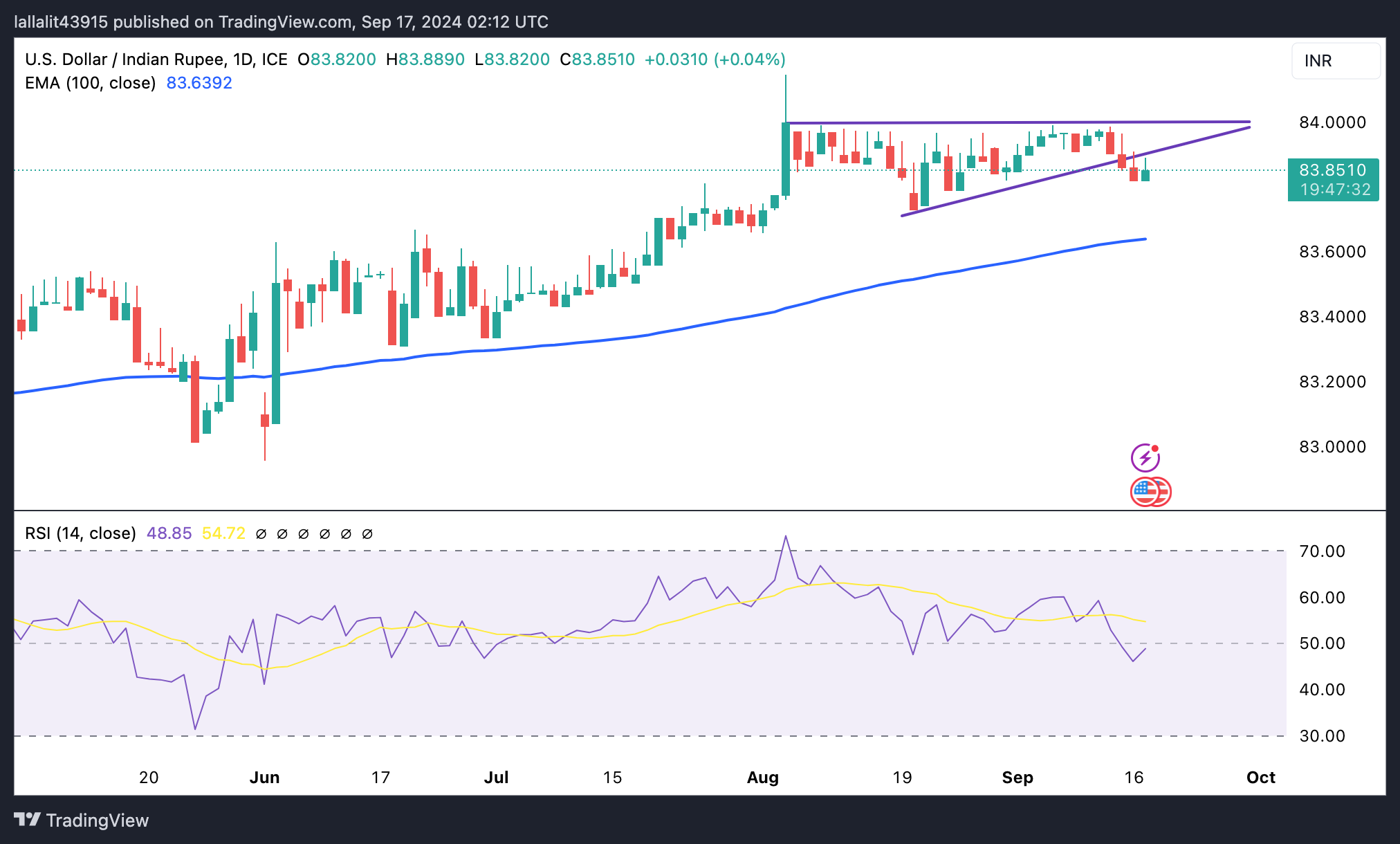USD/INR recovers ahead of Indian WPI Inflation, US Retail Sales data
- Indian Rupee (INR) loses ground in Tuesday’s Asian session.
- Renewed USD demand, higher oil prices undermine the INR; growing expectation of deeper Fed rate cut might cap its downside.
- Indian WPI Inflation and US Retail Sales data will be the highlights later on Tuesday.
The Indian Rupee (INR) edges lower on Tuesday, snapping the three-day winning streak. The robust US Dollar (USD) demand from local importers, particularly oil companies, weighs on the local currency. Additionally, the rebound in crude oil prices might limit the INR’s upside as India is the third-largest oil consumer after the United States (US) and China.
Nonetheless, the firmer bets on the jumbo Federal Reserve (Fed) rate cut, weaker Greenback and significant foreign fund inflows into Indian equities might support the appreciation of the INR. Investors will keep an eye on the Indian Wholesale Price Index (WPI) Inflation, Food and Fuel reports for August on Tuesday. On the US docket, the Retail Sales will be published, which is expected to rise 0.2% MoM in August versus a 1.0% rise in July.
Daily Digest Market Movers: Indian Rupee seems vulnerable as traders await the key events
- The Indian Wholesale Price Index (WPI) Inflation is expected to ease to 1.80% YoY in August from 2.04% in July.
- India's economy is estimated to grow at a rate of around 7.5% or more, according to Reserve Bank of India (RBI) Governor Shaktikanta Das. This projection surpasses the RBI's current forecast of 7.2% for the ongoing financial year.
- The US NY Empire State Manufacturing Index improved to 11.5 in September from a decline of 4.7 in August, better than the estimation of a 3.9% decrease.
- Fed fund futures show investors are increasingly betting the US Fed will cut by 50 basis points (bps) instead of 25 bps. Traders are now pricing in a nearly 67% chance of a reduction of 50 bps, up from 50% on Friday, according to the CME FedWatch Tool.
- "We had favoured a 50bp cut, but the latest job and inflation numbers suggest officials will more likely vote in favour of 25bps”, said ING Bank analysts.
Technical Analysis: USD/INR still maintains constructive bias
The Indian Rupee weakens on the day. According to the daily chart, the bullish outlook of the USD/INR pair remains intact as the price holds above the key 100-day Exponential Moving Average (EMA). However, further downside cannot be ruled out as the 14-day Relative Strength Index (RSI) stands in the bearish zone below the midline.
A decisive break above the 83.90-84.00 region, support-turned resistance level and psychological mark, could spur another bounce back to the immediate upside barrier around 84.50.
On the downside, the low of September 16 at 83.82 acts as an initial support level for USD/INR. Any follow-through selling below this level will expose the 100-day EMA at 83.64.

Indian Rupee FAQs
The Indian Rupee (INR) is one of the most sensitive currencies to external factors. The price of Crude Oil (the country is highly dependent on imported Oil), the value of the US Dollar – most trade is conducted in USD – and the level of foreign investment, are all influential. Direct intervention by the Reserve Bank of India (RBI) in FX markets to keep the exchange rate stable, as well as the level of interest rates set by the RBI, are further major influencing factors on the Rupee.
The Reserve Bank of India (RBI) actively intervenes in forex markets to maintain a stable exchange rate, to help facilitate trade. In addition, the RBI tries to maintain the inflation rate at its 4% target by adjusting interest rates. Higher interest rates usually strengthen the Rupee. This is due to the role of the ‘carry trade’ in which investors borrow in countries with lower interest rates so as to place their money in countries’ offering relatively higher interest rates and profit from the difference.
Macroeconomic factors that influence the value of the Rupee include inflation, interest rates, the economic growth rate (GDP), the balance of trade, and inflows from foreign investment. A higher growth rate can lead to more overseas investment, pushing up demand for the Rupee. A less negative balance of trade will eventually lead to a stronger Rupee. Higher interest rates, especially real rates (interest rates less inflation) are also positive for the Rupee. A risk-on environment can lead to greater inflows of Foreign Direct and Indirect Investment (FDI and FII), which also benefit the Rupee.
Higher inflation, particularly, if it is comparatively higher than India’s peers, is generally negative for the currency as it reflects devaluation through oversupply. Inflation also increases the cost of exports, leading to more Rupees being sold to purchase foreign imports, which is Rupee-negative. At the same time, higher inflation usually leads to the Reserve Bank of India (RBI) raising interest rates and this can be positive for the Rupee, due to increased demand from international investors. The opposite effect is true of lower inflation.



